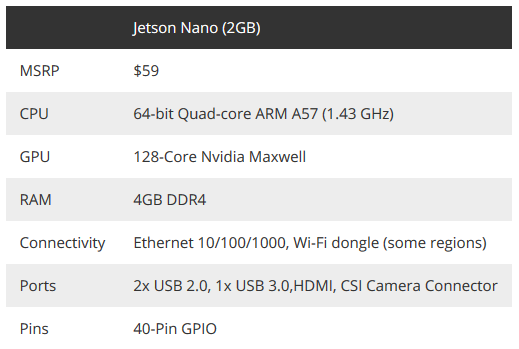Although Raspberry Pi boards are great for doing all sorts of tasks and are capable of recognizing objects, but when it comes to real-time image recognition, they can be a little sluggish. In 2019, Nvidia arrived with an A.I.-focused Pi rival in the $99 Jetson Nano. Yeah, the 4 GB Nano at the time had four times as much RAM as the top-level Pi, but it was more than twice as expensive and Wi-Fi wasn’t available.

Quick forward to 2020 and Nvidia is back with a 2 GB version of the Jetson Nano that sells for a more affordable $59 and comes with a compatible USB Wi-Fi dongle in the box for consumers in certain markets (including America). The new Nvidia Jetson Nano 2 GB, is designed to make A.I. more accessible to hobbyists, children and aspiring developers.
Nvidia is also offering free online training and certification programs for A. I to help more hobbyists make use of its platform. There is also an established group of developers who have shared tutorials and open-source projects since the almost identical 4 GB Jetson Nano has been on the market for a year and a half. You can even buy robot kits for Jetson to create.

Jetson Nano 2GB vs Jetson Nano 4GB
The 2 GB Nano gets power over USB Type-C is an improvement from the 4 GB model where the older model had a proprietary barrel connector. The older model comes with a power supply of 5V, 4A (it could also do 5W over a micro USB connection) and you will have to carry your USB-C adapter of at least 5V, 3A for the new one, although many of us have drawers full of them already.
The Nano 2 GB has fewer USB ports, with only one USB 3.0 and two USB 2.0 ports versus 4 USB 3.0 ports on the 4 GB model. It also has HDMI only, while there is also a DisplayPort connector in the more costly model. Bundling the Wi-Fi dongle, however, is a massive bonus for someone who wants to use the board and is not near an Ethernet router.
Jetson Nano vs Raspberry Pi
The Jetson Nano 2 GB, like any recent Raspberry Pi, has a 40-pin GPIO connector and a CSI camera slot. The camera port is compatible with Raspberry Pi camera modules, which is good news for anyone who wants to use image recognition to create a robot or IoT device. Raspberry Pi HATs (including the best Raspberry Pi HATs) could and should work from a GPIO pin-out perspective, but for Jetson, but the software to take advantage of individual HATs may or may not exist for Jetson.
Where the official Raspberry Pi operating system is Raspberry Pi OS, the Debian port, the eLinux edition of Ubuntu is Jetson Nano’s. So, while you may be able to get a lot of the same software for Nvidia’s board, you can’t just download and use every software package that’s intended for the Pi without any modifications.
It is unlikely that the Jetson Nano 2 GB will take mindshare away from the Raspberry Pi, but with manufacturers who want to create more A.I.-intensive projects, it has a chance to gain critical mass.
